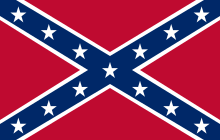A Confederate flag flies over the capitol of South Carolina.
 |
| "Confederate flag in Columbia, SC" by Billy Hathorn |
Echos of its design may be found in the flags of Alabama, Arkansas, and Florida and yet these flags, were not the flag of the Confederacy; they never were. This was:
And this
And this
That last one is not off-center, by the way, it just involves a staggering amount of white. Called "the Stainless Banner" or -- and I swear I am not making this up -- "the white man's flag" by its creator, the vast expanse of white was intended to symbolize the "supremacy of the white man." Seriously. The guy who designed the longest serving national flag of the confederacy had this to say about its symbolism:
"As a people we are fighting maintain the Heaven-ordained supremacy of the white man over the inferior or colored race; a white flag would thus be emblematical of our cause." —William T. Thompson (April 23, 1863), Daily Morning News
So where are those flags and why aren't they the same as the one than everyone calls "The Confederate Flag?" What's this flag?
Or this one?
They're not national flags of the Confederacy but they're pretty similar. They're battle flags; as the war dragged on the battle flag motif was worked into the national Confederate flags but absent the absurd fields of white, those star crossed bars on a red field are flags of the armies that fought in open rebellion against the United States Government. In particular, the first one -- the square -- is the flag of the Army of Northern Virginia, better known as General Robert E Lee's army. The latter, the rectangle, is the battle flag of the Army of Tennessee which, even if you majored in history in college, there's a good chance you've never heard of.
Quick! Name a battle the Army of Tennessee fought in! Unless you came up with "The Battle of Chattanooga" you're in the majority; the Army of Tennessee endured a series of lopsided defeats as parts of the Confederate attempts to keep Sherman from setting fire to Atlanta.
In fact, the only name that the average person might recognize from the Army of Tennessee, save for the names of the people shooting at it, is that of its Cavalry commander: Nathan Bedford Forrest. Forrest was, by most accounts, a capable cavalry commander rising to the rank of Lt. General during the war. Overshadowed by confederate cavalry luminaries like JEB Stewart, Forrest made his mark on history in the post-war years when he joined - and very likely served as the Grand Wizard of - the Klu Klux Klan, a terrorist organization devoted to white supremacy and resistance to Reconstruction.
The Klan, formed by Confederate veterans in Pulaski Tennessee in 1866, returned to its roots during a resurgence in the mid 20th Century, adopting the flag of the Army of Tennessee as a symbol of - as historian Gordan Rhea puts it - "their ideal that the negro is not the equal to the white man."
This is to say - clearly - that the flag generally understood as "the Confederate Flag" is not and never was a symbol of the Confederate cause nor even the romanticized battles that cris-crossed Virginia in the early 1860s. "The Confederate Flag" as used today is an obscure symbol of an obscure army, and one that would likely have been lost to history were it not for its reinvigoration as a symbol of racial division and hatred in the mid 20th century.
Far more than treason or slavery or any of the other complex issues surrounding the Civil War, the flag today stands for massive resistance, jim crow, segregation, and opposition to the civil rights movement. It marks the bearer as a bigot, whatever protests they may raise to the contrary.
If you want to tell people you're a rebel, try this instead:

.svg/800px-Flag_of_the_Confederate_States_of_America_(1861-1863).svg.png)
.svg/800px-Flag_of_the_Confederate_States_of_America_(1865).svg.png)
.svg/800px-Flag_of_the_Confederate_States_of_America_(1863-1865).svg.png)


No comments:
Post a Comment